bonnet Citroen DS4 RHD 2014.5 1.G Owner's Manual
[x] Cancel search | Manufacturer: CITROEN, Model Year: 2014.5, Model line: DS4 RHD, Model: Citroen DS4 RHD 2014.5 1.GPages: 444, PDF Size: 12.99 MB
Page 7 of 444
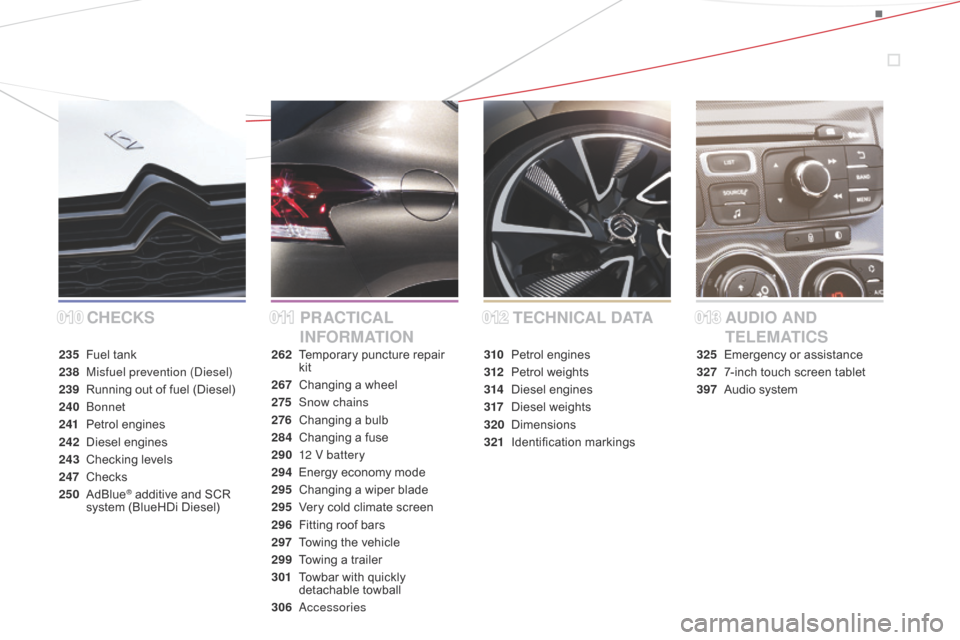
CHECKSPR ACTICAL
INFORMATIONTECHNICAL DATA
AUDIO AND
TELEMATICS
235 Fuel tank
238
M
isfuel prevention (Diesel)
239
R
unning out of fuel (Diesel)
240
Bonnet
241
Pe
trol engines
242
D
iesel engines
243
C
hecking levels
247
C
hecks
250
Ad
Blue
® additive and SCR
system (BlueHDi Diesel) 262
T
emporary puncture repair
kit
267
C
hanging a wheel
275
S
now chains
276
C
hanging a bulb
284
C
hanging a fuse
290
1
2 V battery
294
E
nergy economy mode
295 C hanging a wiper blade
295 V ery cold climate screen
296
F
itting roof bars
297
T
owing the vehicle
299
T
owing a trailer
301
T
owbar with quickly
detachable towball
306
A
ccessories 310
Pe
trol engines
312
Pe
trol weights
314
D
iesel engines
317
D
iesel weights
320
D
imensions
321
I
dentification markings
0120130100 11
325 Emergency or assistance
327
7
-inch touch screen tablet
397
A
udio system
Page 12 of 444
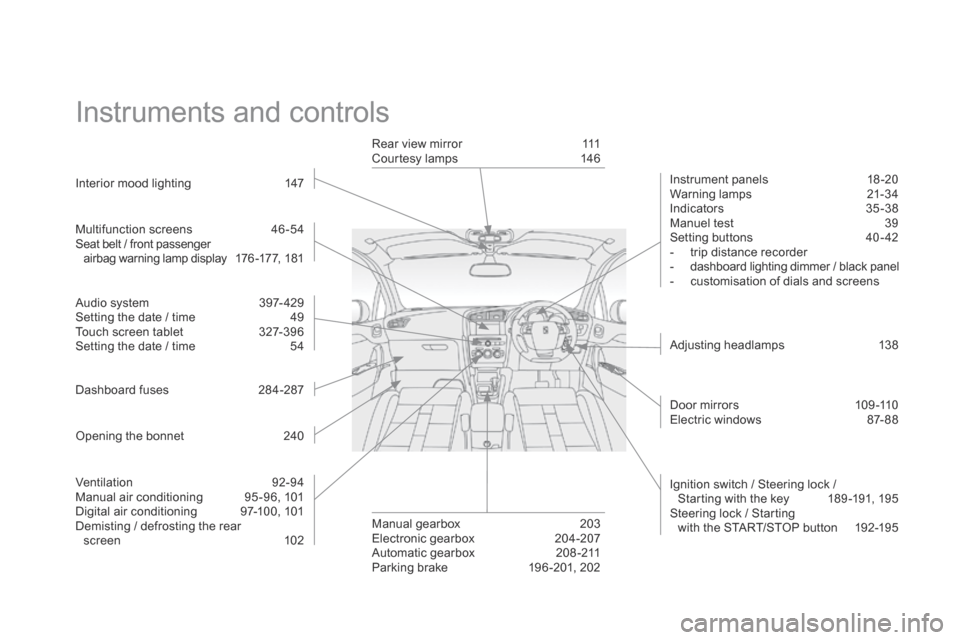
Instruments and controls
Instrument panels 18 -20
Warning lamps 2 1-34
Indicators
35
-38
Manuel test
3
9
Setting buttons
4
0 - 42
-
t
rip distance recorder
-
d
ashboard lighting dimmer / black panel
-
c
ustomisation of dials and screens
Adjusting headlamps
1
38
Door mirrors
1
09 -110
Electric windows
87
- 88
Dashboard fuses
2
84-287
Opening the bonnet
2
40
Multifunction screens
4
6 -54
Seat belt / front passenger
airbag warning lamp display
1
76 -177, 181
Manual gearbox
2
03
Electronic gearbox
20
4-207
Automatic gearbox
2
08 -211
Parking brake
1
96 -201, 202
Rear view mirror
1
11
Courtesy lamps
1
46
Ventilation
9
2-94
Manual air conditioning
9
5 -96, 101
Digital air conditioning
9
7-100, 101
Demisting / defrosting the rear screen
1
02
Audio system
3
97- 429
Setting the date / time
4
9
Touch screen tablet
3
27-396
Setting the date / time
5
4
Interior mood lighting
1
47
Ignition switch / Steering lock /
Starting with the key
1
89 -191, 195
Steering lock / Starting with the START/STOP button
1
92-195
Page 15 of 444
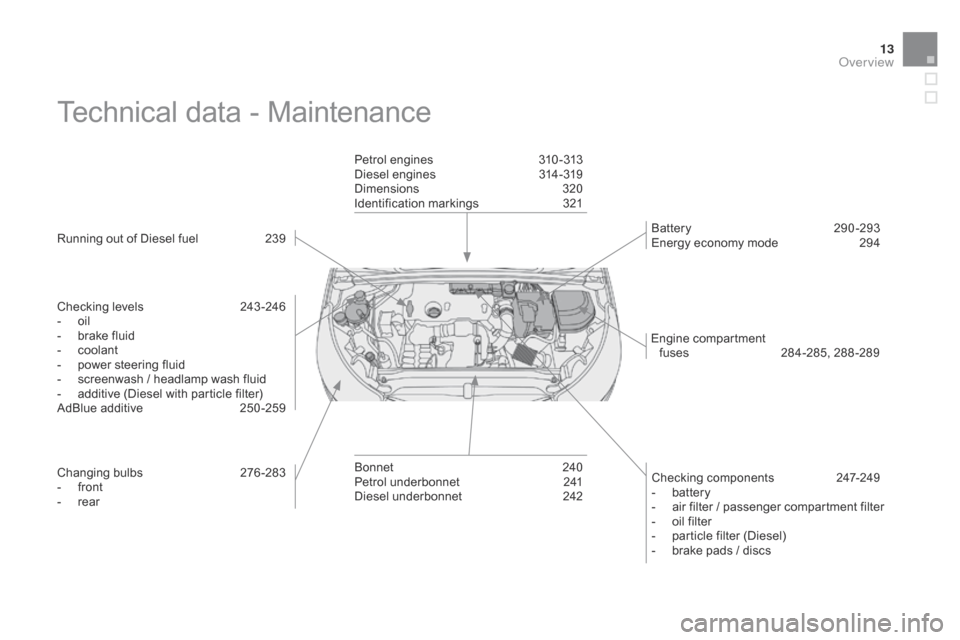
13
Technical data - Maintenance
Running out of Diesel fuel 239
Checking levels
2
43 -246
-
o
il
-
b
rake fluid
-
c
oolant
-
p
ower steering fluid
-
s
creenwash / headlamp wash fluid
-
a
dditive (Diesel with particle filter)
AdBlue additive
2
50 -259
Changing bulbs
2
76-283
-
f
ront
-
r
ear Petrol engines
3
10 -313
Diesel engines
3
14-319
Dimensions
3
20
Identification markings
3
21
Bonnet
2
40
Petrol underbonnet
2
41
Diesel underbonnet
2
42Checking components
2
47-249
-
b
attery
-
a
ir filter / passenger compartment filter
-
o
il filter
-
p
article filter (Diesel)
-
b
rake pads / discs
Battery 2
90-293
Energy economy mode 2 94
Engine compartment
fuses
28
4-285, 288-289
Over view
Page 37 of 444
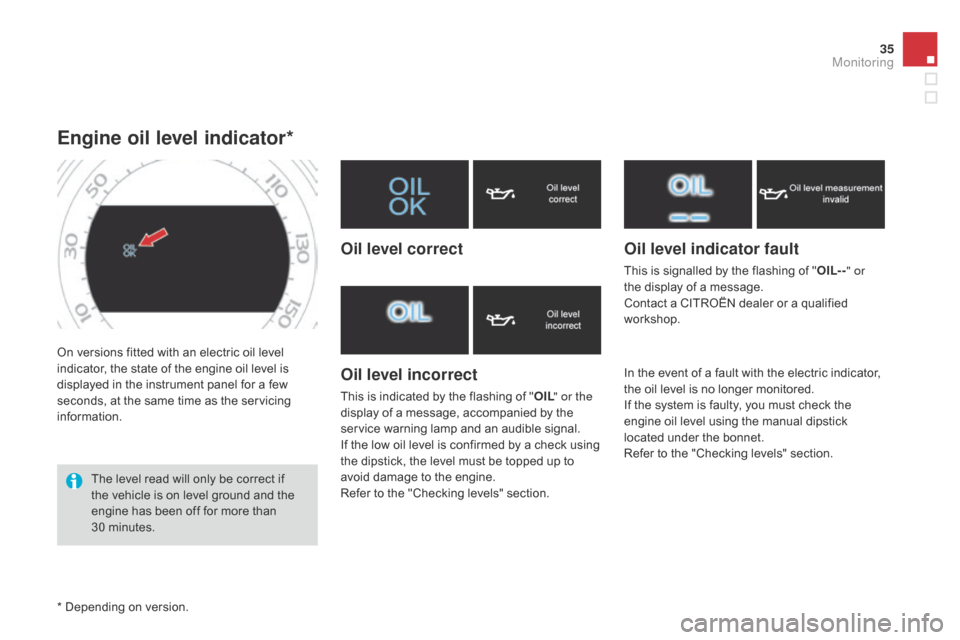
35
On versions fitted with an electric oil level
indicator, the state of the engine oil level is
displayed in the instrument panel for a few
seconds, at the same time as the servicing
information.
Engine oil level indicator*
The level read will only be correct if
the vehicle is on level ground and the
engine has been off for more than
30
m
inutes.
Oil level correct
Oil level incorrect
This is indicated by the flashing of " OIL" or the
display of a message, accompanied by the
service warning lamp and an audible signal.
If the low oil level is confirmed by a check using
the dipstick, the level must be topped up to
avoid damage to the engine.
Refer to the "Checking levels" section.
Oil level indicator fault
This is signalled by the flashing of " OIL- -" or
the display of a message.
Contact a CITROËN dealer or a qualified
workshop.
In the event of a fault with the electric indicator,
the oil level is no longer monitored.
If the system is faulty, you must check the
engine oil level using the manual dipstick
located under the bonnet.
Refer to the "Checking levels" section.
* Depending on version.
Monitoring
Page 81 of 444
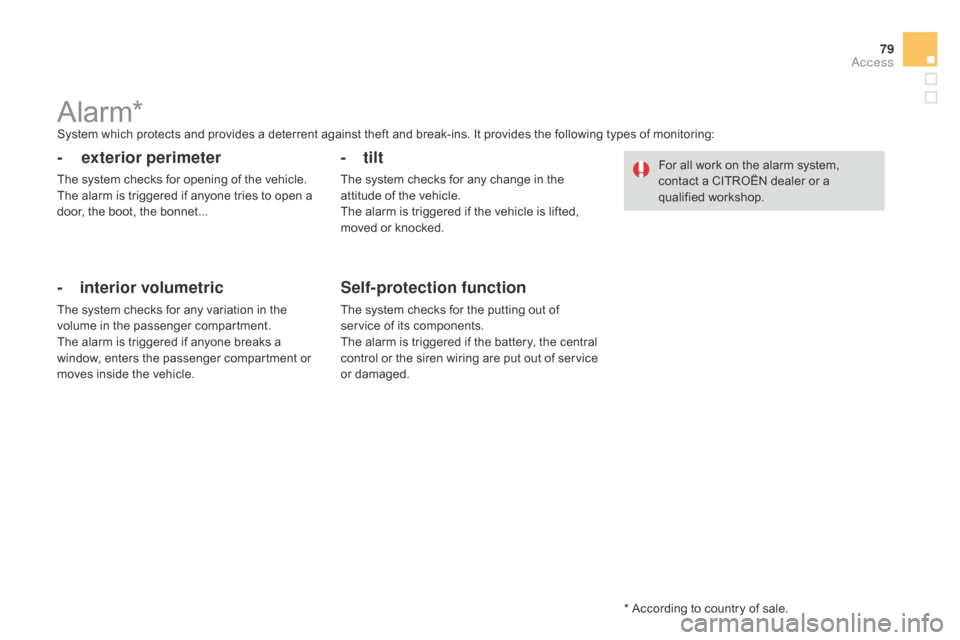
79
Alarm*System which protects and provides a deterrent against theft and break-ins. It provides the following types of monitoring:
- exterior perimeter
The system checks for opening of the vehicle.
The alarm is triggered if anyone tries to open a
door, the boot, the bonnet...
- interior volumetric
The system checks for any variation in the
volume in the passenger compartment.
The alarm is triggered if anyone breaks a
window, enters the passenger compartment or
moves inside the vehicle.
- tilt
The system checks for any change in the
attitude of the vehicle.
The alarm is triggered if the vehicle is lifted,
moved or knocked.
Self-protection function
The system checks for the putting out of
service of its components.
The alarm is triggered if the battery, the central
control or the siren wiring are put out of service
or damaged.For all work on the alarm system,
contact a CITROËN dealer or a
qualified workshop.
* According to country of sale.
Access
Page 145 of 444
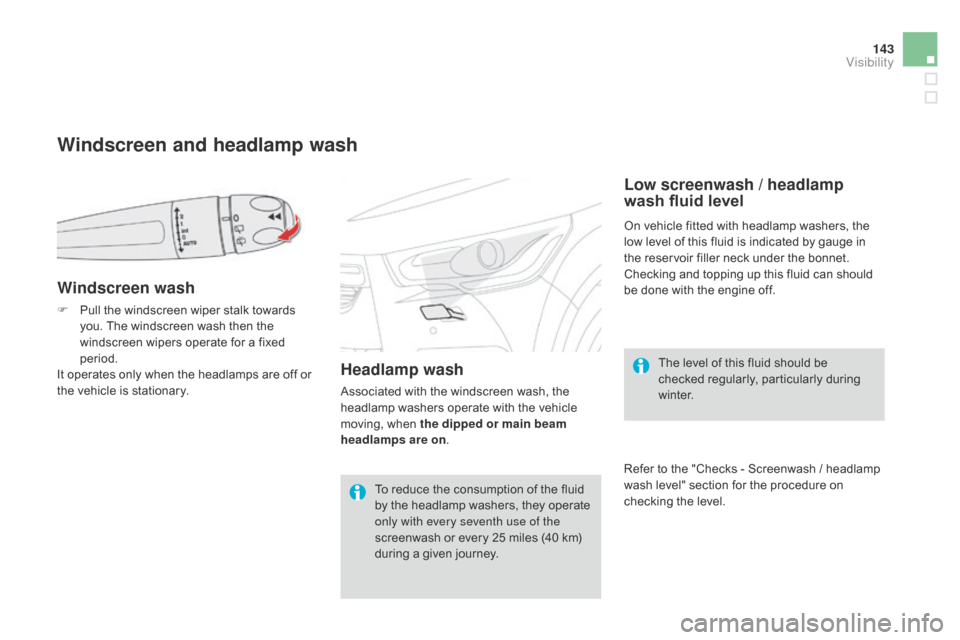
143
Windscreen and headlamp wash
Windscreen wash
F Pull the windscreen wiper stalk towards you. The windscreen wash then the
windscreen wipers operate for a fixed
period.
It operates only when the headlamps are off or
the vehicle is stationary.
Low screenwash / headlamp
wash fluid level
On vehicle fitted with headlamp washers, the
low level of this fluid is indicated by gauge in
the reservoir filler neck under the bonnet.
Checking and topping up this fluid can should
be done with the engine off.
The level of this fluid should be
checked regularly, particularly during
w i n t e r.
Refer to the "Checks - Screenwash / headlamp
wash level" section for the procedure on
checking the level.
Headlamp wash
Associated with the windscreen wash, the
headlamp washers operate with the vehicle
moving, when the dipped or main beam
headlamps are on .
To reduce the consumption of the fluid
by the headlamp washers, they operate
only with every seventh use of the
screenwash or every 25 miles (40 km)
during a given journey.
Visibility
Page 221 of 444

219
This system requires a specific battery with a
special specification and technology (reference
numbers available from a CITROËN dealer or a
qualified workshop).
Fitting a battery not listed by CITROËN
introduces the risk of malfunction of the
system.
In the event of a malfunction with the system,
the "ECO OFF" switch warning lamp flashes,
then comes on continuously.
have it checked by a CITROËN dealer or a
qualified workshop.
Operating fault
Maintenance
Before doing anything under the
bonnet, deactivate the Stop & Start
system to avoid any risk of injury
resulting from automatic operation of
START mode.
The Stop & Start system makes use
of advanced technology. All work on
this type of battery must be done only
by a CITROËN dealer or a qualified
workshop.
In the event of a fault in STOP mode, the
vehicle may stall. All of the instrument
panel warning lamps come on.
Depending on version, an alert
message may also be displayed asking
you to put the gear lever into position N
and put your foot on the brake pedal.
It is then necessary to switch off the
ignition, then restart the engine using
the key or the "START/STOP" button.
Driving
Page 241 of 444
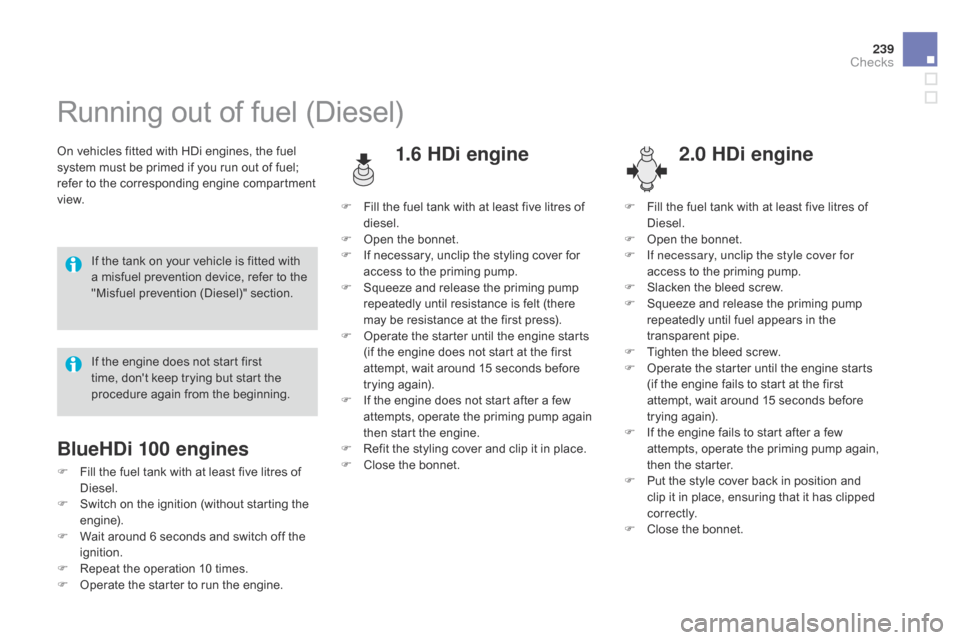
239
Running out of fuel (Diesel)
On vehicles fitted with HDi engines, the fuel
system must be primed if you run out of fuel;
refer to the corresponding engine compartment
view.1.6 HDi engine
If the tank on your vehicle is fitted with
a misfuel prevention device, refer to the
"Misfuel prevention (Diesel)" section.
2.0 HDi engine
If the engine does not start first
time, don't keep trying but start the
procedure again from the beginning.
BlueHDi 100 engines
F Fill the fuel tank with at least five litres of Diesel.
F
S
witch on the ignition (without starting the
engine).
F
W
ait around 6 seconds and switch off the
ignition.
F
R
epeat the operation 10 times.
F
O
perate the starter to run the engine. F
F
ill the fuel tank with at least five litres of
diesel.
F
O
pen the bonnet.
F
I
f necessary, unclip the styling cover for
access to the priming pump.
F
S
queeze and release the priming pump
repeatedly until resistance is felt (there
may be resistance at the first press).
F
O
perate the starter until the engine starts
(if the engine does not start at the first
attempt, wait around 15 seconds before
trying again).
F
I
f the engine does not start after a few
attempts, operate the priming pump again
then start the engine.
F
R
efit the styling cover and clip it in place.
F C lose the bonnet.F
F
ill the fuel tank with at least five litres of
Diesel.
F
O
pen the bonnet.
F
I
f necessary, unclip the style cover for
access to the priming pump.
F
S
lacken the bleed screw.
F
S
queeze and release the priming pump
repeatedly until fuel appears in the
transparent pipe.
F
T
ighten the bleed screw.
F
O
perate the starter until the engine starts
(if the engine fails to start at the first
attempt, wait around 15 seconds before
trying again).
F
I
f the engine fails to start after a few
attempts, operate the priming pump again,
then the starter.
F P ut the style cover back in position and
clip it in place, ensuring that it has clipped
c o r r e c t l y.
F
C
lose the bonnet.
Checks
Page 242 of 444

Bonnet
Opening
F Open the front left door.
F P ull the interior bonnet release lever A ,
located at the bottom of the door aperture. F
P
ush the exterior safety catch B to the left
and raise the bonnet.
F
U
nclip the stay C from its housing on the
back of the bonnet.
F
F
ix the stay in the notch to hold the bonnet
open.
The location of the interior bonnet
release lever prevents opening of
the bonnet while the front left door is
closed. Do not open the bonnet in high winds.
When the engine is hot, handle the
exterior safety catch and the bonnet
stay with care (risk of burns).
Before doing anything under the bonnet,
switch off the Stop & Start system to
avoid any risk of injury resulting from an
automatic change to START mode.
Closing
F Take the stay out of the support notch.
F
C lip the stay in its housing on the back of
the bonnet.
F
L
ower the bonnet and release it at the end
of its travel.
F
P
ull on the bonnet to check that it is
secured correctly.
The cooling fan may star t after switching
off the engine: take care with ar ticles and
clothing that might be caught by the fan
blades.
Because of the presence of electrical
equipment under the bonnet, it is
recommended that exposure to water
(rain, washing, ...) be limited.
Page 245 of 444
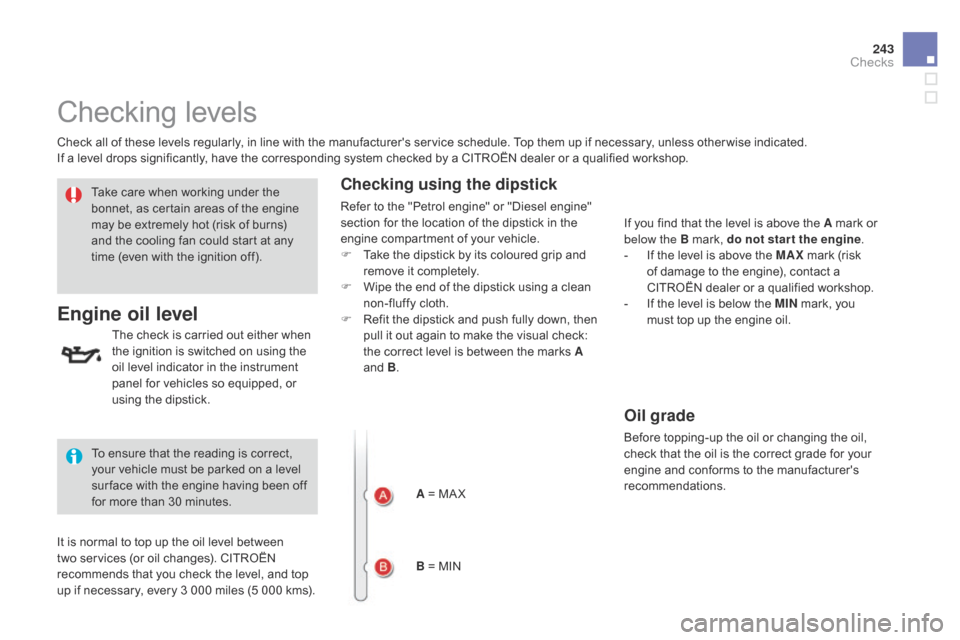
243
Checking levels
Check all of these levels regularly, in line with the manufacturer's service schedule. Top them up if necessary, unless other wise indicated.
If a level drops significantly, have the corresponding system checked by a CITROËN dealer or a qualified workshop.
Engine oil level
It is normal to top up the oil level between
two services (or oil changes). CITROËN
recommends that you check the level, and top
up if necessary, every 3 000 miles (5 000 kms).The check is carried out either when
the ignition is switched on using the
oil level indicator in the instrument
panel for vehicles so equipped, or
using the dipstick.
Take care when working under the
bonnet, as certain areas of the engine
may be extremely hot (risk of burns)
and the cooling fan could start at any
time (even with the ignition off).
Checking using the dipstick
Refer to the "Petrol engine" or "Diesel engine"
section for the location of the dipstick in the
engine compartment of your vehicle.
F
T
ake the dipstick by its coloured grip and
remove it completely.
F
W
ipe the end of the dipstick using a clean
non-fluffy cloth.
F
R
efit the dipstick and push fully down, then
pull it out again to make the visual check:
the correct level is between the marks A
and B .
A = MA X
B = MIN If you find that the level is above the A mark or
below the B mark, do not star t the engine
.
-
I
f the level is above the MAX mark (risk
of damage to the engine), contact a
CITROËN dealer or a qualified workshop.
-
I
f the level is below the MIN mark, you
must top up the engine oil.
To ensure that the reading is correct,
your vehicle must be parked on a level
sur face with the engine having been off
for more than 30 minutes.
Oil grade
Before topping-up the oil or changing the oil,
check that the oil is the correct grade for your
engine and conforms to the manufacturer's
recommendations.
Checks